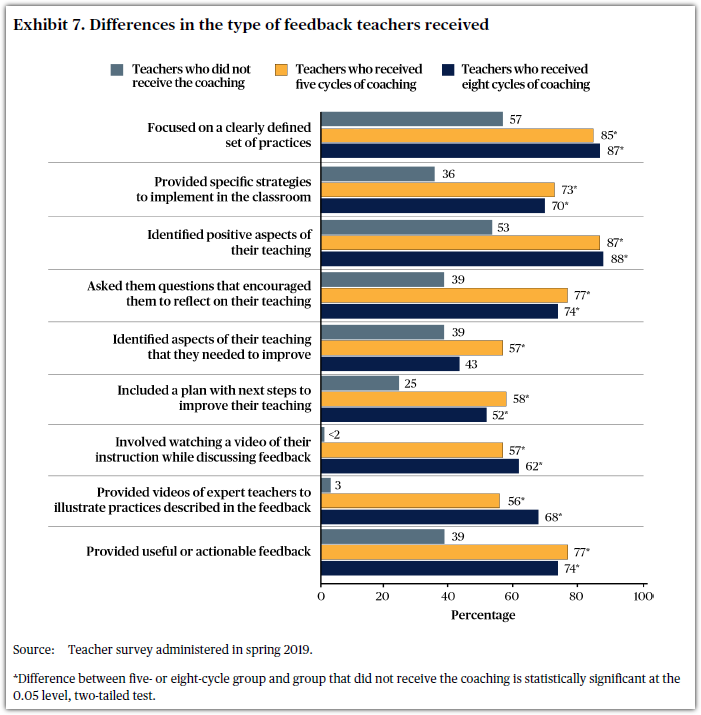By some estimates, teachers make an average of 1,500 decisions each school day. Among all those decisions, there are bound to be some great calls…and some missteps. A recent study from the Institute of Education Sciences by Melissa Clark and colleagues supports the importance of providing teachers with feedback on their actions—particularly through a medium that allows them to explicitly see how they responded to various scenarios—as a core part of helping teachers develop and improve.
During the 2018-2019 school year, the researchers examined over 350 4th- and 5th-grade teachers from 14 large urban and suburban districts who taught math, English language arts (ELA), or both. Each school in the study was randomly assigned to one of three types of coaching for their teachers: five rounds of observation and feedback based on classroom videos, eight rounds, or no external observation and feedback (so the district’s business as usual). Teachers submitted classroom videos each round and received virtual coaching by trained coaching specialists external to the district, rather than district or school staff. The study did not mention whether or not these coaching cycles factored into the district’s teacher evaluation process.
The study’s key findings were that 1) five cycles of video-based coaching improved student achievement; 2) eight cycles of video-based coaching had little to no effect on student achievement; and 3) independent, external coaching positively affected teachers’ perceptions of the feedback they received.
Teachers receiving the five-cycle coaching approach improved student achievement in ELA by 3 percentile points on state assessments compared to teachers that did not receive coaching. Novice teachers (those in the classroom for five years or less) and those with weaker teaching practices (in the bottom third of the sample based on observation scores) at the start of the study saw even greater improvement in both math and ELA compared to similar teachers who did not receive additional coaching.
Surprisingly, however, the eight-cycle approach, with the same format as the five-cycle model, did not have an impact on student learning. The researchers hypothesized that the larger number of cycles became more time-consuming and did not give enough time between cycles for teachers to practice or reflect on their coaching sessions.
Another important outcome of the study was that, according to the teachers themselves, the external coaching approach provided higher-quality feedback. Based on a survey of teachers, those who received coaching through the five- or eight-cycle approaches reported more positive perceptions of feedback than those receiving the “business as usual” approach, on every measure. In particular, teachers who received coaching reported getting “useful or actionable feedback” at nearly twice the rate of those teachers who did not receive the coaching (77% compared to 39%).

| Graphic reprinted from Clark, M., Max, J., James-Burdumy, S., Robles, S., McCullough, M., Burkander, P., & Malick, S. (2022). Study of Teacher Coaching Based on Classroom Videos: Impacts on Student Achievement and Teachers’ Practices. |
The positive effects of the five-observation cycle may be because it led to far more feedback than what many teachers currently receive (at least based on current teacher evaluation systems; teachers may receive more feedback through mentoring or informal drop-ins). Research has found that teachers who are observed four or more times per year have a more positive reaction to the evaluation process, but NCTQ’s 2022 State of the States report found that only 14 states require observations of all teachers multiple times per year. When NCTQ dug into school district policies, we found that tenured teachers are observed on average 2.4 times per evaluation cycle and non-tenured teachers an average of 3.3 times per cycle. These policies mean that many teachers are missing a key opportunity to learn how they can become more effective.
The importance of observation feedback is made even more clear when considering how little feedback teachers received under the “business as usual” approach. Teachers in the five-cycle approach received an average of 222 minutes of constructive feedback based on their video observations, compared to only 20 minutes of feedback for teachers who received their district’s “usual strategies for supporting teachers.”
While district leaders may be envisioning a steep cost for this program, the study claims that this approach is far less expensive, per unit increase in student achievement, than other interventions such as teacher pay for performance, class size reduction, and incentives to transfer high-performing teachers, coming in at approximately $228 per student for the five-cycle approach. Could it be then that video-based coaching with an external coach specialist could be a win-win-win for students, teachers, and district budgets?
More like this

How are districts observing and providing feedback to teachers?

Seven ways to make improving teacher evaluation worth the work

What do teachers think of their evaluation feedback?


